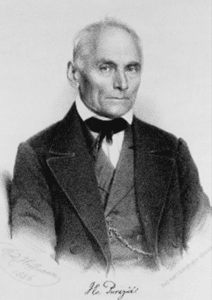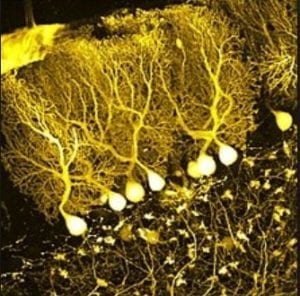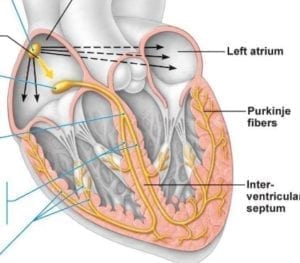 |
Johannes Purkinje (1787 –1869) was one of the best-known scientists of his time, now remembered for discovering, in 1837, the large neurons with branching dendrites of the cerebellum (Purkinje cells), and the fibers conducting electrical impulses from the atria to the ventricles of the heart (Purkinje fibers). In addition, he introduced into medicine the terms plasma and protoplasm, and was the first to use a microtome for making thin tissue slices for microscopic examination. His other far-flung research interests included describing the structure of the sweat glands (1833); noting the protein-digesting power of pancreatic extracts (1836); carrying out studies on hearing and the genesis of nystagmus; and investigating the effects of opium, camphor, belladonna, and turpentine on humans. In 1838, he described and illustrated the presence of melanin in the cells of the substantia nigra, and the changes occurring in the eye when the intensity of light was altered.
 |
|
| Purkinje cells |
Purkinje was in born in the village of Libochowitz, near the river Elbe, in Bohemia, then part of the Austrian empire. After graduating from high school, he entered the Order of the Piarists as a teacher of ancient languages. In 1806 he went to Prague with the idea of becoming a writer, then decided on medicine, not intending to become a practicing physician, but expecting that the medical sciences would give him an insight into nature.1 In 1818 he took up a position as assistant in anatomy and physiology, and in 1819 graduated in medicine from the Charles University with a dissertation on aspects of vision.
 |
Between 1823 and 1850 Purkinje was chair of physiology and pathology at the University of Breslau (now Wrocław), appointed over the prejudices of the anti-Slav German faculty upon the recommendations of Goethe and Alexander von Humboldt, who had read his writings. His beginnings were inauspicious. Speaking German with a Czech accent, he was once told by a colleague that he would be better understood if he lectured in Latin. His lectures at first were unpopular with his students, and the University objected to his asking for a microscope on the basis that the whole place would be cluttered up with equipment and the students would waste time doing experiments instead of listening to lectures. Eventually, however, his achievements gained recognition, and in 1839 the Prussian government endowed for him the first ever institute devoted exclusively to physiology. There, in addition to his important work on medicine, he also carried out secondary and less important projects, such as those on dreams, fingerprinting, acoustics, embryology of the tadpole, the skin of cucumber plants, and methods of fertilization in the plant world.1
After seventeen years in Breslau, Purkinje returned as professor of physiology to his alma mater in Prague, the Charles University, where now the Austrian government gave him a splendid laboratory, an adequate salary, and a capable assistant. But his productive days in research were over. He involved himself in Czech politics; was elected to the senate; wrote copiously; founded and edited several journals; and devoted himself to furthering the education of the young. He died in 1869 at the age of eighty-two, remembered as a modest man who was driven from one discovery to another, often leaving the details to others but stimulating them to carry out the further research.
Reference
- Robinson V. Johannes Evangelista Purkinje (1787-1869). The Scientific Monthly, 1929:29:217-229.
GEORGE DUNEA, MD, Editor-in-Chief

Leave a Reply